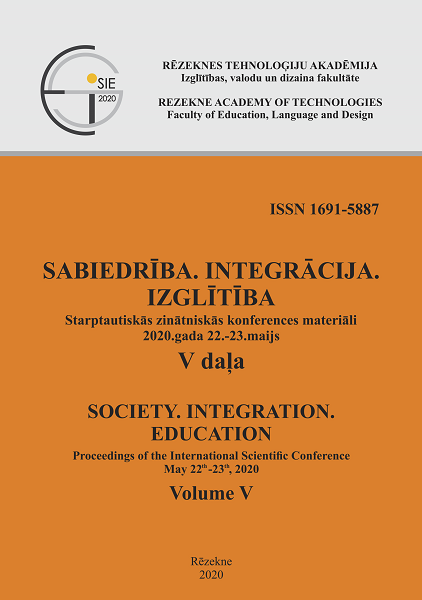THE DEVELOPMENT OF TOWN-SHIELDS’ PLANNING IN BISHOPRICS OF LIVONIA DURING THE 13TH–14TH CENTURIES
DOI:
https://doi.org/10.17770/sie2020vol5.4875Keywords:
Bishopric centre, cathedral building-type, town-shield, fortified urban structures, the State of the Teutonic OrderAbstract
Traditions of the Christianity centres’ formation can be found in Jerusalem’s oldest part where instead of domestic inhabitants’ dwellings the second king of Israel (around 1005 BC–965 BC) David built his residence on a top of the Temple Mount surrounded by deep valleys. His fortress – the City of David protected from the north side by inhabitants’ stone buildings on a slope was an unassailable public and spiritual centre that northwards extended up to the Ophel used for the governance. David’s son, king of Israel (around 970–931 BC) Solomon extended the fortified urban area where Templum Solomonis was built. In Livonia, Bishop Albrecht obtained spacious areas, where he established bishoprics and towns. At foothills, residential building of inhabitants like shields guarded Bishop’s residence. The town-shield was the Dorpat Bishopric’s centre Dorpat and the Ösel–Wiek Bishopric’s centre Haapsalu. The town of Hasenpoth in the Bishopric of Courland (1234–1583) was established at subjugated lands inhabited by the Cours: each of bishopric's urban structures intended to Bishop and the Canonical Chapter was placed separately in their own village. The main subject of research: the town-shields’ planning in Livonia. Research problem: the development of town-shields’ planning at bishoprics in Livonia during the 13th and 14th century have been studied insufficiently. Historians in Latvia often do not take into account studies of urban planning specialists on historical urban planning. Research goal: to determine common and distinctive features of town-shield design in bishoprics of Livonia. Research novelty: town-shield plans of Archbishop’s and their vassals’ residences and capitals in Livonian bishoprics subjected to the Riga Archbishopric are analyzed. Results: study formation of Livonian town-shields’ layout and structure of the 13th and 14th centuries. Main methods: inspection of town-shields in nature, analysis of archive documents, projects, cartographic materials.
Downloads
References
Bākule, I. (1990). Pilsētas izpēte dabā 1989. – 1990. gadā. Aizputes pilsētas reģenerācijas priekšlikums. Volume 2. Rīga: Restaurācijas institūts.
Bākule, I. (1990). Reģenerācijas priekšlikums. Aizputes pilsētas reģenerācijas priekšlikums. Volume 3. Rīga: Restaurācijas institūts.
Broce, J., K. (2002). Zīmējumi un apraksti. 3. sējums: Latvijas mazās pilsētas un lauki. Rīga: Zinātne.
Caune, A. (2014). Arheoloģiskā pētniecība Latvijas 13. – 16. gs. mazpilsētās. In Latvijas Zinātņu Akadēmijas Vēstis. Part A. Volume 68. Nr. 5–6. Rīga: , 4–22.
Caune, A., & Ose, I. (2004). Latvijas viduslaiku pilis, IV. Latvijas 12. gadsimta beigu – 17. gadsimta vācu piļu leksikons. Rīga: Latvijas vēstures institūta apgāds.
Dirveiks, I. (1992). Lielstraupes pils komplekss. Arhitektoniskā izpēte. Rīga: manuscript (Archives of National Heritage Board of Latvia, file Nr. 39.195-48 III).
Heinrici Chronicon. (1993). Rīga: Zinātne.
Jemeļjanovs, E. (2001). Pārskats par arheoloģiskās uzraudzības darbu veikšanu Straupes viduslaiku pils un vecpilsētas teritorijā no 2001. gada 14. līdz 18. augustam. Turaida: manuscript (Archives of National Heritage Board of Latvia, file Nr. 58583-8 I).
Latvijas pilsētas. (1999). Rīga: Preses nams.
Livonijas piļu attēli no marķīza Pauluči albuma = Abbildungen der Livländischen Burgen im Album des Marquis Paulucci. (2008). Rīga: Latvijas vēstures institūta apgāds.
von Löwis of Menar, K. (1922). Burgenlexikon für Alt-Livland. Riga: Walters und Rapa.
von Löwis of Menar, K. (1900). Kokenhusen und Umgebung. Riga: Verlag von N. Kymmel.
Malvess, R. (2010). Kokneses pils būvvēsture. 13. gadsimts–17. gadsimta 20. gadi. In Latvijas viduslaiku pilis, VI. Pētījumi par Vidzemes un Zemgales pilīm. Rīga: Latvijas vēstures institūta apgāds, 237–273.
Mäesalu, A. (1997). Über den Stand der archäologischen Forschungsarbeit in Dorpat (Tartu). In Lübecker Kolloquium zur Stadtarchäologie im Hanseraum: Stand, Aufgaben und Perspektiven. Lübeck: Schmidt-Römhild, 343–350.
Meiβner, C. (1917). Das schöne Kurland. Ein deutsches Land. München: R. Piper & Co Verlag.
Ose, I. (2001). Latvijas viduslaiku pilis, II. Latvijas viduslaiku piļu pētniecība 18. – 20. gadsimtā. Rīga: Latvijas vēstures institūta apgāds.
Ozola, S. (2019). The Development of the Catholic Cathedral Building-type at Bishoprics’ Towns on the Baltic Sea Southern Coast during the 13th – 14th Centuries. In Landscape Architecture and Art. Volume 14, Number 14 Jelgava: Latvia University of Life Sciences and Technologies, 23–43, DOI: 10.22616/j.landarchart.2019.14.03.
Ozola, S. (2015). Sacral Building in Towns of the Bishopric of Courland. In Art Tempus. Volume 3. Daugavpils: Institute of Art, Daugavpils University, 66–104.
Plētiens, E. (2015). Livonijas mazpilsētas: kas tās bija un kāda bija to ietekme? In Latvijas Vēstures institūta žurnāls. Zinātniskie raksti. Nr. 3 (96). Rīga: Latvijas vēstures institūts, 5–44.
Plētiens, E. (2016). Pils un pilsēta Livonijā 13. – 16. gadsimtā: Straupes piemērs. In Latvijas viduslaiku pilis, IX. Pētījumi par Vidzemes, Kurzemes un Zemgales pilīm. Rīga: Latvijas Vēstures institūta apgāds, 176–208.
von Schlippenbach, U., F. (1809). Malerische Wanderungen durch Kurland. Riga, Leipzig: C. J. G. Hartmann.
Schulz, A. (1805). Beschreibung der Provinz Kurland. Mitau: J. F. Steffenhagen und Sohn.
Šterns, I. (1997). Latvijas vēsture. 1290–1500. Rīga: Apgāds Daugava.
Vasiļjevs, J. (1969). Pilsētu plānojuma attīstība. In Latviešu etnogrāfija. Rīga: Zinātne, 175–181.
Vītola, T. (1999). Raunas pils rekonstrukcijas mēģinājums. In Latvijas viduslaiku pilis, I. Pētījumi par arhibīskapijas pilīm. Rīga: Latvijas vēstures institūta apgāds, 241–257.
Zandberga, R. (1980). Aizputes arhitektoniski pilsētbūvnieciskās struktūras attīstības vēsture. Rīga: Latvijas PSR Kultūras ministrijas Kultūras pieminekļu restaurēšanas projektēšanas kantoris.


